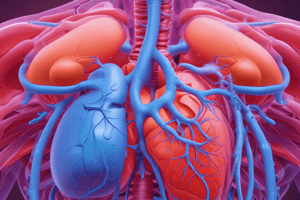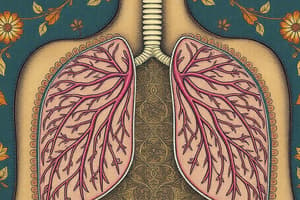Podcast
Questions and Answers
What is the broader term that includes intake of air/ oxygen, and its utilization in the body cells to produce energy?
What is the broader term that includes intake of air/ oxygen, and its utilization in the body cells to produce energy?
Respiration
What is the simpler, mechanical process of inhaling and exhaling air called?
What is the simpler, mechanical process of inhaling and exhaling air called?
Breathing
Breathing includes respiration.
Breathing includes respiration.
False (B)
What are the two main parts of the respiratory cycle?
What are the two main parts of the respiratory cycle?
How many breaths per minute do normal adults take?
How many breaths per minute do normal adults take?
Newborn babies breathe 60 times per minute.
Newborn babies breathe 60 times per minute.
An increase in CO2 content of the blood decreases the breathing rate.
An increase in CO2 content of the blood decreases the breathing rate.
What is the name of the process of taking in air?
What is the name of the process of taking in air?
What is another name for inhalation?
What is another name for inhalation?
What are the two main factors contributing to the increase in size during inspiration?
What are the two main factors contributing to the increase in size during inspiration?
What moves upwards and outwards due to the contraction of the external intercostal muscles?
What moves upwards and outwards due to the contraction of the external intercostal muscles?
Which muscles are relaxed during inspiration?
Which muscles are relaxed during inspiration?
The diaphragm expands downwards during inspiration.
The diaphragm expands downwards during inspiration.
What is the dome-shaped sheet of muscular tissue situated towards the base of the lungs called?
What is the dome-shaped sheet of muscular tissue situated towards the base of the lungs called?
The diaphragm normally remains arched upward.
The diaphragm normally remains arched upward.
Flashcards
Respiration
Respiration
The process of taking in oxygen and using it to produce energy in cells.
Breathing
Breathing
The mechanical process of inhaling and exhaling air.
Respiratory Cycle
Respiratory Cycle
The complete process of inspiration (inhaling), expiration (exhaling), and a brief pause.
Normal Breathing Rate (Adults)
Normal Breathing Rate (Adults)
Signup and view all the flashcards
Newborn Breathing Rate
Newborn Breathing Rate
Signup and view all the flashcards
Breathing Rate & CO₂
Breathing Rate & CO₂
Signup and view all the flashcards
Inspiration (Inhalation)
Inspiration (Inhalation)
Signup and view all the flashcards
Inspiration - Muscles Involved
Inspiration - Muscles Involved
Signup and view all the flashcards
External Intercostal Muscles
External Intercostal Muscles
Signup and view all the flashcards
Diaphragm Contraction
Diaphragm Contraction
Signup and view all the flashcards
Expiration (Exhalation)
Expiration (Exhalation)
Signup and view all the flashcards
Expiration - Muscles Involved
Expiration - Muscles Involved
Signup and view all the flashcards
Alveoli
Alveoli
Signup and view all the flashcards
Capillaries
Capillaries
Signup and view all the flashcards
Pulmonary Artery
Pulmonary Artery
Signup and view all the flashcards
Pulmonary Vein
Pulmonary Vein
Signup and view all the flashcards
Pharynx
Pharynx
Signup and view all the flashcards
Larynx
Larynx
Signup and view all the flashcards
Trachea
Trachea
Signup and view all the flashcards
Bronchus
Bronchus
Signup and view all the flashcards
Study Notes
Respiration vs. Breathing
- Respiration is a broader term encompassing air intake, oxygen utilization, and energy production in body cells.
- Breathing is a mechanical process of inhaling and exhaling air, involving muscles but not necessarily energy production.
Respiratory Cycle
- The respiratory cycle includes inspiration (breathing in), expiration (breathing out), and a short pause.
- Normal adults typically breathe 12-18 times per minute.
- Newborns breathe 60 times per minute.
- An increased CO₂ level in the blood triggers a faster breathing rate.
Inspiration (Inhalation)
- Inspiration results from an increase in the thoracic cavity size.
- This is due to the combined action of the ribs and diaphragm.
- Ribs move upwards and outwards, and the external intercostal muscles contract. This expands the chest cavity.
- The diaphragm, a sheet of muscle below the lungs, contracts and flattens, further expanding the chest cavity.
- Internal intercostal muscles are relaxed during this process.
Studying That Suits You
Use AI to generate personalized quizzes and flashcards to suit your learning preferences.




